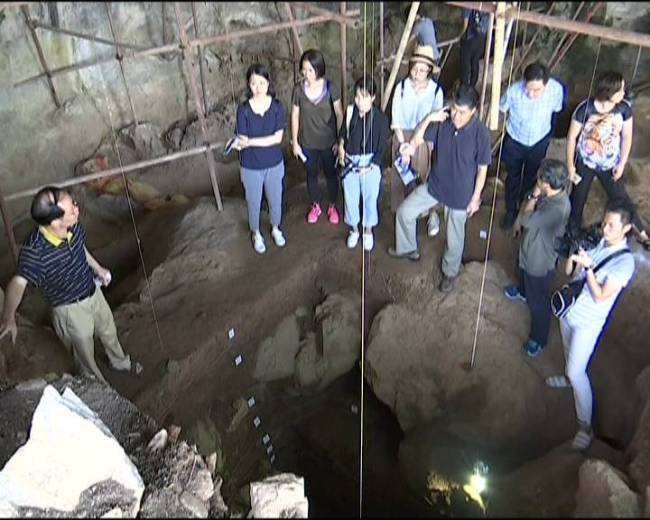Se trata de un arma que fue aprovechada como elemento decorativo. Esta peculiar pieza nos sirve también de excusa para hablar de una cueva con casi 1.000 muestras de arte parietal paleolítico...
Gipuzkoa, paraíso del león cavernario. Noticias de Gipuzkoa
 |
| Roberto Pellitero, María Quiñones, Asier Gómez y Ana Belén Conde, midiendo y preparando el león cavernario para su viaje a Burgos. (Iker Azurmendi) |
El felino hallado en Arrikrutz hace medio siglo se expondrá al público por primera vez en Burgos y en Donostia con el objetivo de dar a conocer un periodo del territorio en el que los leones campaban a sus anchas.
“El de Arrikrutz pesaba 250 kilos, cuando los leones de hoy en día no llegan a los 190” “Se alimentaban de bisontes, renos, ciervos, caballos y hasta de rinocerontes lanudos” “La subida de la temperatura y la caza del hombre les llevaron a su extinción”...
Hallan fósil de cráneo humano de hace 16.000 años en el sur de China | Spanish.xinhuanet.com
Un cráneo humano que data de hace unos 16.000 años ha sido descubierto en una tumba en la región autónoma de la etnia zhuang de Guangxi, en el sur de China.
Es el único cráneo completo perteneciente a aquel periodo hallado en el sur de China, destacó el investigador Yu Minghui.
En 2014 se encontró un sistema de cuevas de más de 100 metros cuadrados en una montaña a 13 kilómetros de la sede central del distrito de Long'an, y la excavación comenzó en junio del año siguiente.
Además del cráneo, se hallaron más de 10.000 instrumentos de piedra en el lugar.
Pileta de Prehistoria: Humanos prosperaron en África durante una supererupción en Indonesia
---
Famed Archaeologist 'Discovered' His Own Fakes at 9,000-Year-Old Settlement
A famed archaeologist well-known for discovering the sprawling 9,000-year-old settlement in Turkey called Çatalhöyük seems to have faked several of his ancient findings and may have run a "forger's workshop" of sorts, one researcher says.
James Mellaart, who died in 2012, created some of the "ancient" murals at Çatalhöyük that he supposedly discovered; he also forged documents recording inscriptions that were found at Beyköy, a village in Turkey, said geoarchaeologist Eberhard Zangger, president of the Luwian Studies Foundation. Zangger examined Mellaart's apartment in London between Feb. 24 and 27, finding "prototypes," as Zangger calls them, of murals and inscriptions that Mellaart had claimed were real.
"He used the same approach for over 50 years," Zangger told Live Science. "He would first acquire a tremendously broad and deep knowledge [about the area he was interested in]. Then, he would try to use this knowledge to develop a coherent historic panorama," Zangger said. This process in itself is not uncommon for an archaeologist or historian. The only difference is that legitimate researchers then look for evidence that either supports or refutes their ideas. Instead, "Mellaart would fabricate drawings of artifacts and translations of alleged documents to reinforce his theories," Zangger said...
16,000-yr-old fossil human skull found in south China- China.org.cn
A human skull dating back about 16,000 years has been found in a tomb in south China's Guangxi Zhuang Autonomous Region.
It is the only complete skull from that period ever found in southern China, according to researcher Yu Minghui.
On a mountain about 13 km away from the county seat of Long'an, a cave system covering more than 100 square meters was discovered in 2014. Excavation started in June 2015.
In addition to the skull, more than 10,000 stone stools were found at the site.
Pileta de Prehistoria: Humans thrived in South Africa through the Toba super-volcanic eruption ~ 74,000 years ago
Más noticias / More news










No hay comentarios:
Publicar un comentario